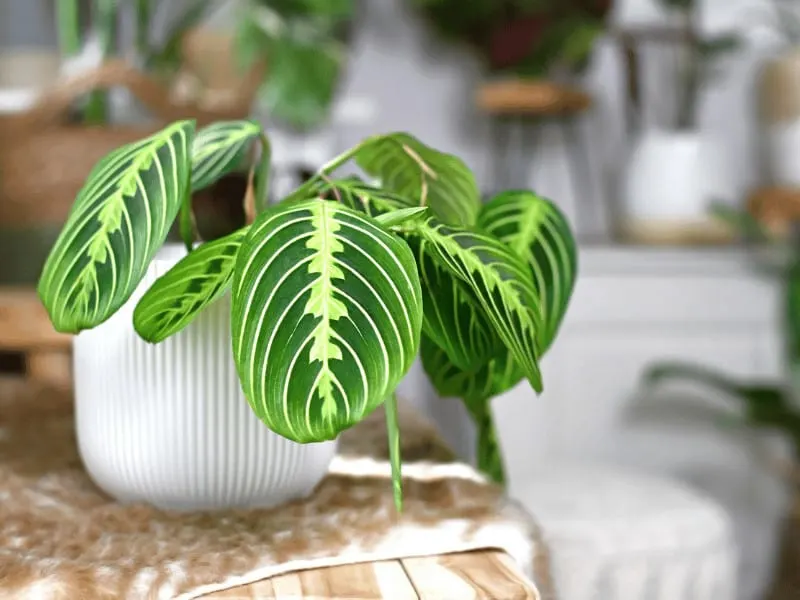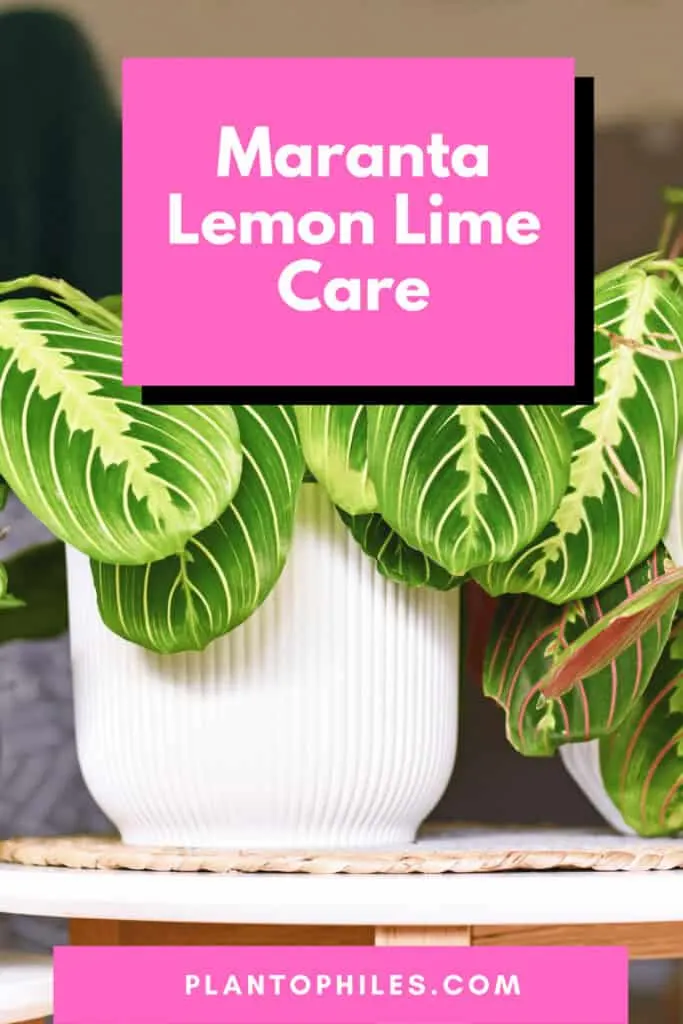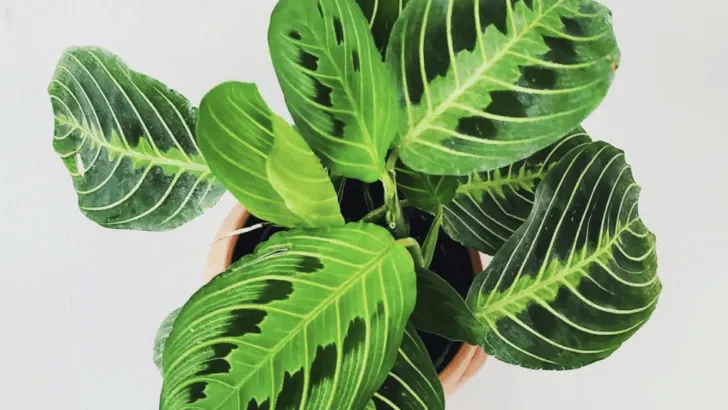(image credit: IG plantzaddyy)
You are reading this article to learn more about Maranta Lemon Lime care and more about the Maranta leuconeura, which is the scientific name.

Takeaways
| Species | Maranta leuconeura |
| Synonyms | Prayer plant, Rabbit's foot |
| Family | Marantaceae |
| Genus | Maranta |
| Growth | Clumping, spreading |
| Height | 0.3 feet |
| Width | 2.0 feet |
| Soil | Well-draining soil mix |
| Watering | Water every 7-10 days |
| Light | Bright indirect |
| Temperature | 60.0 - 80.0 °F (15.6 - 26.7 °C) |
| Fertilizer | Every two weeks in spring and summer |
| Toxicity | Non-toxic |
Maranta Lemon Lime
Maranta plants are famous as Prayer Plants for their ability to open and close their leaves. Most varieties open their leaves in the morning and close at night. The beautiful leaves resemble praying hands hence the name prayer plant.
This plant belongs to the Marantaceae plant family. It consists of Marantas, Stromanthe, Calathea, and Ctenanthe. All these species are native to Asia, Africa, and Brazil.
According to The American Society for the Prevention of Cruelty to Animals, Maranta plants are non-toxic to pets. So your cats and dogs can happily roam around these plants.
Prayer plants have colorful foliage. Maranta Lemon Lime looks lovely in a floor planter or hanging basket.
Table of Contents
Maranta Lemon Lime Care
Maranta Lemon Lime plant likes peat-based potting soil with regular watering about once a week from spring to summer. Provide bright indirect light. Maintain an indoor temperature between 60 to 80 degrees Fahrenheit ( 15.5 to 26.7 degrees Celsius).
Maranta Lemon Lime is considered slightly more difficult to grow compared to other houseplants such as Pothos or Monsteras.

What Soil is Best for the Prayer Plant?
You can grow the Maranta Lemon Lime in any general houseplant potting mix. I have been using the following recipe:
- 1 part potting soil
- 1 part coconut coir or peat moss
- 1 part perlite
Always ensure your potting mixture is well-draining. This is done by preparing a well-draining mixture and choosing a pot with drainage holes. Perlite and coarse sand will improve the drainage of the potting mixture.
This plant needs rich, well-draining soil with a pH ranging from 5.5 to 6.0 inside and outdoors. The recommended USDA hardiness zones are 11 and 12, according to Missouri Botanical Gardens.
How do You Water a Maranta Lemon Lime?
Water Maranta Lemon Lime once a week in spring and summer.
The Lemon Lime plant does not like to get dry. A steady watering schedule is crucial. This is not a plant for under-waterers. As a simple rule, water your plant when the leaves start curling towards the center.
Water the plant well so that the soil remains moist at all times. But do not let the soil stay saturated with roots in the water. This plant does not like to dry out completely or remain in soggy soil. I water mine once every week.
During cold months of winter, this Maranta plant will go dormant; therefore reduce the watering as it needs less water to grow and survive. To water Maranta Lemon Lime plant, always use distilled, rain, or filtered water as this plant cannot tolerate tap water.
How much Light does the Lemon Lime need?
Place your Maranta Lemon Lime in bright sunlight that is filtered. This plant will not tolerate direct sun as it will eventually scorch the leaves, killing your plant. Therefore it is best to keep it near shaded windows.
What is the ideal Temperature for a Maranta Lemon Lime?
This plant grows in temperatures between 60 to 80 degrees Fahrenheit ( 15.5 to 26.7 degrees Celsius). A temperature lower than 60 degrees Fahrenheit( 15.5 degrees Celsius) will damage the leaves.
What Humidity is best for Maranta Lemon Lime?
The Maranta Lemon Lime, like other variations of this species, loves high humidity. Remember, all plants from the Marantaceae plant family require humidity. You can ensure this by misting your plant regularly.
Another method is to set up a container or tray of water. As this water evaporates, the air humidity level rises. It is important to ensure the plant is not resting in the water.
If the indoor humidity level at your place is lower than 65%, I recommend getting a humidifier to maintain the required air moisture.
How much Fertilizer for a Lemon Lime?
Fertilizers help plants have a steady growth. I feed my Maranta Lemon Lime every two weeks from spring to fall. I like to use water-soluble fertilizer that is dissolved at half strength. This will establish the plant in the growing phase.
Ensure you use high-quality fertilizer because the cheap ones will damage your plant. Skip fertilizer or reduce the quantity in winter as the plant is not growing much.
Repotting
If your Maranta Lemon Lime is root-bound and has slow growth, it is time to repot it. For repotting, I would suggest choosing a pot that is 1-2 inches larger and wider than the previous one. Make sure to refresh the potting soil every year in early spring. To repot, follow the following steps:
- Gently remove your plant from the soil.
- Inspect the root system and trim the mushy or unhealthy roots.
- Ensure that you use clean instruments to trim the roots.
- Fill half of the new pot with the previously discussed potting mix.
- Now place the root ball and pour the soil around the roots.
- Gently press to firm the soil without compacting it.
- Water the soil well until fully saturated; water only when necessary next time.
Ensure you provide extra attention to your Maranta Lemon Lime for a few weeks after repotting. The plant might suffer from transplant shock without the right care.
Because of the shallow roots, I suggest potting your Maranta Lemon Lime in shallow pots instead of deep ones. To learn about repotting, read our article about how to repot a plant.
Pruning
Trim the yellowing or diseased foliage to promote new growth on your Maranta plant. Pruning not only improves the appearance of your plant but also encourages vigorous, new growth.
There is no strict time or schedule about when you should prune the Maranta Lemon Lime. You can do it at any time of the year. Ideally, spring is the best time, according to my experience, since the plant can easily recover from any pruning stress.
Maranta Lemon Lime Propagation
Maranta Lemon Lime can be propagated using stem cuttings and by division.
Stem Cuttings
The Maranta Lemon Lime is best propagated via stem cuttings. And the good news is it’s easy to propagate. Just follow the detailed steps discussed below:
- Find a healthy stem on your Maranta plant and locate where the leaf connects with the stem. This point is called a node.
- Cut the stem just below the leaf node using sterilized, sharp scissors. You can also use a sharp knife.
- Make sure your cutting has at least one node intact because this is the point where new roots will form.
- Dip the end of the cutting in water and then in the rooting hormone. The rooting hormone allows the cutting to root fast. This step is optional.
- Now you can plant your cutting in the desired mixture. I have planted my cuttings in a mixture of perlite and peat moss. Water the mixture well to keep it moist at all times.
- Cover your pot/container with plastic to create a mini greenhouse. This will ensure high humidity for the Maranta cutting.
- Using scissors, make a few holes in the plastic allowing for ventilation. These holes will also allow the cutting to soak some sunlight.
- Makes sure the cutting is growing in a sunny location.
- Once the roots are long enough (1 inch, 2.5cm), your cutting can be transplanted to a new pot.
Root Division
To propagate your Maranta plant via root division, follow the steps below:
- Divide the Maranta Lemon Lime into several sections. Do this by gently removing the root ball from the soil.
- Inspect and cut the damaged brown roots with a clean pair of pruning shears.
- Make a section carefully without damaging the roots. Each section should have at least one stem and leaf with many roots.
- Pot these sections separately in small pots. Choose the pot size and number according to your sections.
- Keep the newly potted plants moist and warm for the first few weeks to have new growth.
Maranta Lemon Lime Flowers
With proper care and good lighting, the Maranta Lemon Lime will develop tiny white flowers on the thin stems. The blooming season for this plant is usually summer.
Growth
This plant has attractive green leaves, with white or lime green lines running down the leaf-spine. The leaves of this are varied in shades of dark, light green, and yellow colors. Both sides of the leaves are beautifully patterned to create a sophisticated look.
The leaves are broad and medium-sized. This plant has a mature height of 12 inches (30 cm) and a spread of 14 inches (35.5 cm). Once the plant matures, the leaves can get 6 inches (15 cm).
Common Problems for Maranta Lemon Lime
Spider Mites
Spider mites are a common pest for both indoor and outdoor plants. These mites are extremely tiny and hardly visible. But they leave webbings on the leaves and make the plant look dusty. Mites range in colors of green, brown, and black.
Spider mites multiply quickly because an adult female can lay up to 100 eggs within three weeks. Once these eggs hatch and the larva starts feeding on the leaves, the mites will change colors. Normally the growth process takes 14 days, but it will take less time to multiply in summer.
Remember, this plant likes to grow in high humidity, whereas spider mites cannot tolerate high humidity. Therefore it is best to ensure proper humidity for your Rabbit’s Foot plant to avoid pests.
Spider mites are first noticed by the presence of webbings between stems and leaves. Yellow leaves or brown spots are an additional symptom. The mites, however, look like black dots. They feed on the plant tissues as well as sap.
This feeding deprives the plant of all necessary nutrients leading to slow growth.
The first step is to wash your plant with a strong stream of water. Now use plant-based oils to suffocate the mites and their eggs. The most common one is neem oil, which a herbal pesticide and repellent. It can prevent other pests also.
You can prepare your own oil using cottonseed, garlic oil, and clover. To prevent future infections, make sure you wash the undersides of the leaves regularly. Keep your Maranta plant clean and dry at all times.
Mealybugs
Mealybugs confirm their presence with a white, powdery substance. The plant also has curly leaves with a sticky substance. This sticky substance is called honeydew. It facilitates the growth of sooty mold and attracts ants as well as pests.
It is important to eradicate mealybugs at the earliest because they easily spread to other plants or surfaces on the same plant. This can be done by dabbing these bugs with cotton balls soaked in alcohol.
Brown Leaf Tips
Brown or curly leaf tips indicate your Maranta plant is getting too much sunlight. Another possible reason for this could be chlorine or other salts found in tap water. The entire browning of leaves could be due to low water or humidity.
To solve this issue, use filtered water instead of tap water. I would suggest leaving the water overnight in a can or bucket. You should also consider relocating your plant to a slightly shady place. The last step is to trim the damaged leaves, and soon your plant will again have lush green leaves.
Remember tip curling or browning is a sign from your plant that it’s unhappy. You should examine the root system for any rots and moisture retention.
Leaf Spot
If you find any water-soaked spots on the leaves surface, your plant is definitely suffering from leaf spot disease. This disease can severely damage the foliage of your plant and even kill it if left untreated.
You can reduce the spread of this disease by simply avoiding overwatering. Avoid leaving the leaves wet for too long. Clean the leaves of your plant with neem oil to treat any infections.
Root Rot
This plant has fine, shallow roots that make it susceptible to root rot. Therefore it is extremely important to ensure your plant is growing in well-draining soil. The pot should have at least one drainage hole.
If you notice any symptoms of root rot, immediately check the root ball. Trim the unhealthy roots and, if necessary, repot your Maranta Lemon Lime.
Tips for Growing Maranta leuconeura
- To water the Maranta Lemon Lime plant, I would recommend using water at room temperature. However, prayer-plants enjoy being watered with warm water.
- Add rocks or gravel pieces at the bottom of the pot for good drainage.
- If you want your Maranta Lemon Lemon Lime to pray more, give it sufficient sunlight.
- Avoid misting the leaves daily since it increases the risk of bacterial or fungal infections.
- Choose a location for your plant where it receives a few hours of the morning sun.
- Never let your Maranta plant get too dry in between waterings.
- You can improve the humidity by grouping your Marant plants with other houseplants.
- Regularly check your plant in dry winter months for any pests or bugs.
FAQ
Can this variety of Maranta plants tolerate low light?
This plant can grow in low-light areas if you maintain good airflow.
What soil is best for the Maranta Lemon Lime plant?
A well-draining soil is the best option for growing your Maranta Lemon Lime plant. Place some gravels or add coarse sand to improve the drainage. A well-draining mixture is also necessary to protect your plant from overwatering damage.
My Maranta Lemon Lime has stopped closing its leaves. Why is that?
The ability of your Maranta plant to open or close its leaves is closely related to light conditions. Your plant might be getting too much or too low sunlight. Another possible cause is the soil is either too wet or dry. Make sure you inspect and maintain these two conditions properly.
What is the best indoor location for the Maranta Lemon Lime plant?
Wherever it gets bright, filtered sunlight. You can either place it near a window or any other well-lit place. A few away from direct sun is best to protect the leaves from scorching.
What ingredients in the potting mixture ensure proper drainage and water retention?
Bark and perlite will improve drainage, whereas coco coir will ensure moisture retention. Therefore make sure your custom potting mix has these ingredients for better growth.
My Maranta Lemon Lime plant has become leggy with bleached leaves; what is wrong?
Any houseplant becomes leggy or stretchy due to a lack of sunlight. This happens because the plants start growing toward the light source. Leaf bleaching also indicates lighting issues. Therefore make sure you provide bright, indirect sunlight.
Some leaves on my Maranta plant have started turning yellow. What now?
Yellow leaves on Maranta plants are usually due to overwatering. So make sure you allow your plant to dry before watering next time.
Read next about Maranta Leuconeura (Prayer Plant).
Conclusion
The Maranta Lemon Lime will stand out among other houseplants because of the unique foliage, so you must have one in your plant collection. Just make sure your plant is moving(opening and closing) throughout the day because that indicates it’s growing in the right conditions.
This attractive and unique-foliage plant is worth trying for any plant enthusiast. Give it what it needs, and you quickly have a beautiful Maranta Lemon Lime.


